Environmental Health & Safety from the Director's Desk
|
|
|
|
Greetings!
Welcome to another Miami fall season. As you settle into your semester routine and prepare for the upcoming holidays, EHS would like to highlight two key safety topics. First, fire prevention relating to the season’s decorating plans and celebrations. This newsletter contains a quick reminder of great tips for keeping your office space and home fire safe.
Secondly, October is National Biosafety & Biosecurity Month and the U is again recognizing it throughout the month of October with helpful webinars, vendor sponsored lunch and learns, and the annual lab safety award with prizes! See the Biosafety section below for more exciting details.
As well, you will find other helpful safety topics within this newsletter, including an insightful ergonomic guide – particularly for those who have recently transitioned from desktop computers to laptops, chemical guidance on working with corrosive materials, and key biohazardous waste steps to keep you safe and in compliance.
We hope you find the information in this newsletter informative and useful, and we look forward to continuing to assist you in a safe and productive manner. As a recognition of your efforts in research and safety, you may find us at your lab to award our new, custom University of Miami Laboratory Research Notebook. You see below one of our first awardees, Dr. Helena Solo-Gabriele, receiving her notebook for her attention to safety and distinctive research throughout the pandemic. We are also open to suggestions and nominations, so if you have a safety story to tell or a nomination to make, please feel free to reach out to me with that information!
|
|
|
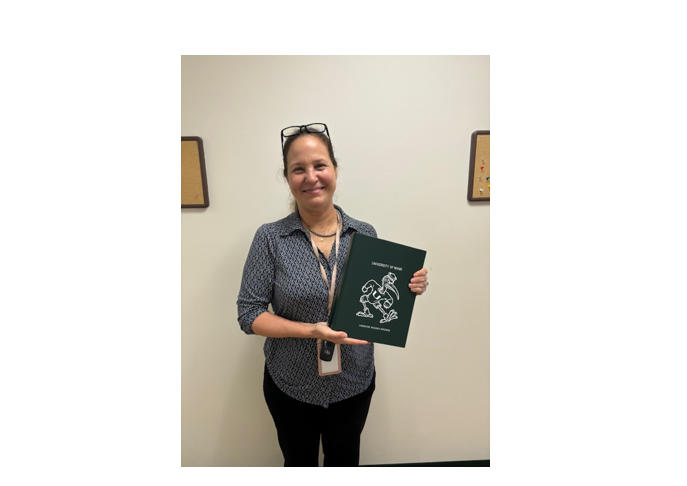
|
|
Warm regards,
Jennifer Laine, DrPH
Executive Director, EHS
|
|
|
|
October is Biosafety & Biosecurity Month!
Each year, we recognize October as Biosafety Month. Last year we celebrated Biosafety Month in a big way with free donuts, free pizza, and awesome prizes for those who attended our educational seminars. We’re bringing the festivities back this year with lively sessions offered weekly. Check out the Biosafety webpage for the schedule of activities.
As always, the Biosafety team remains committed to building a strong safety culture and developing the tools necessary to ensure our researchers can easily and effectively work safely in the lab. For labs, the month is traditionally recognized as a period where we focus on and reinforce our attention to biosafety standards. The Biosafety team has traditionally used this time to highlight some of our major initiatives over the past year. So, in case you missed it:
• The Lab Inspection Cheat Sheet was developed this year as a tool for labs to better understand and prepare for the inspection items highlighted on your annual lab inspection. Have a checklist item that you’re just not sure how to implement? Maybe you’re new to the lab and don’t quite understand yet why it’s a safety concern. Or maybe you want to know more about that checklist item and where the regulation for that item comes from. All this information can be found on the Cheat Sheet.
• Our training offerings have expanded to now being fully offered on ULearn as well as Blackboard ULTRA. Among our new training options, we’ve developed and launched a course called Biosafety for Clinicians. This course provides relevant training for researchers whose primary responsibilities are in the clinic rather than the lab. We’re also planning to introduce video-guided Blackboard trainings soon. This will cater to those who prefer the structured experience of an online course but need the flexibility of on-demand access. We anticipate launching the first of these trainings later this year.
• In addition, we've also revamped our Biological Ancillary Review Assessment (BARA) form to streamline the review process for IRB submissions. You can find more details in the article below!
The BARA Form for IRB Submissions has Been Revamped!
For any lab submitting a research proposal to the Institutional Review Board (IRB), a corresponding Biological Ancillary Review Assessment (BARA) form is required for EHS review. As of August, this form has undergone major revisions for the first time in 4 years. These updates follow policy changes that now include core labs and clinical research collaborators in the same safety review and inspection process as all other research labs on campus. Since these labs will now complete a Biological Hygiene Plan like every other biological lab, we took this opportunity to revise the BARA form to focus solely on details specific to the submitted research proposal.
Our goal was to create a tool that is easier to navigate and more applicable to the safety demands and standards for the agent-specific hazards researchers will encounter in their work. Should you have any questions or comments, as always please contact us at biosafety@miami.edu.
|
|
|

|
|
Tips for Biomedical Wastes
In recognition of Biosafety Month, our team would like to reiterate proper biomedical waste management in the laboratories. Following the steps below will help lead to a safe and compliant workspace.
• Accumulate and dispose of biomedical waste in impermeable red bags that meet ASTM 1709 and ASTM 1922 standards.
• Biomedical waste containers must bear the international infectious substance label and be labeled with our building and room number, street address, and city.
• Helpful hint: EHS suggests pre-printed Avery labels with the lab information that can be placed on the bag ahead of starting use.
• There must be enough room left in a biomedical waste bag to be sealed with a strong gooseneck knot. The general rule is ¾ full is full. (See below for pictures on how to tie this knot!)
• Sharps must be placed into a sharps container.
• Leave room to close your sharps containers. Most sharps containers have a "full" line in them.
• On the Medical campus, take your full waste containers to the designated biomedical waste accumulation area on your floor.
• On the Coral Gables and RSMAES campuses, please submit a signed Chemical Waste Disposal Form to EHS, and EHS will collect and dispose of the containers.
For convenience, EHS has a list of compliant biomedical waste bags on our website from a few of our vendors. If you have any questions or would like to schedule training for your lab, please contact Brian Cumbie.
|
|
|

|
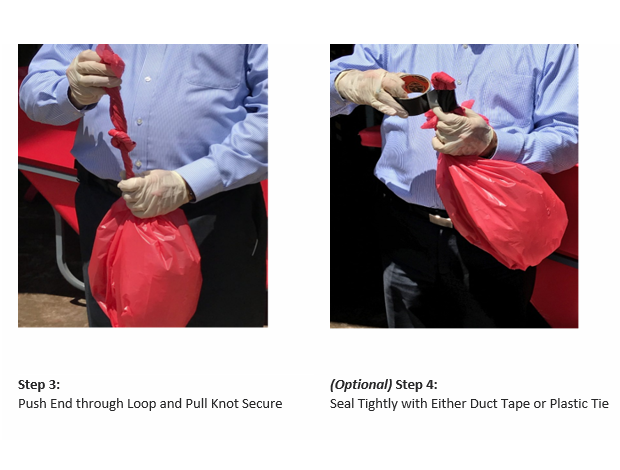
|
|
Holiday Decorating "Do's and Don'ts"
As the holidays approach, EHS wants to remind the University community of some decorating "do's and don'ts:"
|
|
|
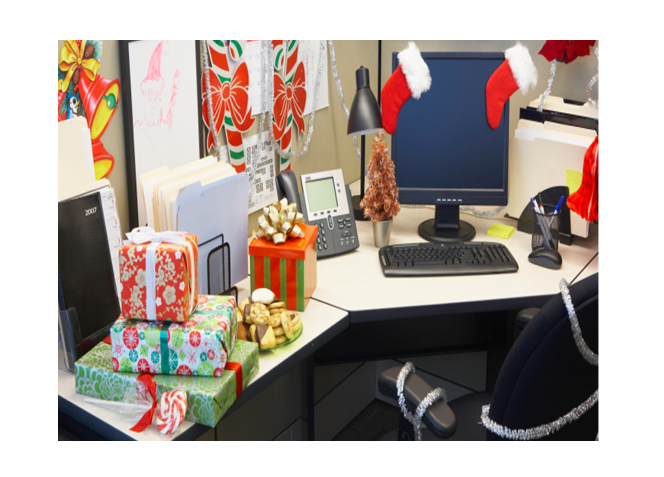
|
|
Do's
• Do use UL-listed decorative lights, decorations, and ornaments.
• Do use artificial holiday trees that are fire-resistant and place indoor trees away from traffic.
• Do unplug holiday lights when you leave the office for the day.
• Do remove all decorations, displays, lights, and/or ornaments after the holiday event or prior to the University's annual holiday closure.
Don'ts
• Do not block doorways or fire safety equipment!
• Do not use decorative sprays or hang decorative materials (lights, ornaments, etc.) on any fire protection equipment (fire extinguishers, sprinkler heads, smoke detectors, fire alarm pull boxes, etc.), on or near exits or emergency lights.
• Do not place decorative materials in any manner that could present a fall or trip hazard, or impede egress.
• Do not bring or burn candles, incense sticks, and/or other related devices/accessories.
For more fire safety information, see our website at Fire Safety | Environmental Health and Safety | University of Miami or contact Christine Daley at 305-243-8443 or c.daley@miami.edu.
|
|
|

|
|
Work flexibility has become a significant part of our lives, often involving the use of laptops. As we adapt to new ways of completing our tasks, it’s crucial to remember that maintaining good posture is essential for our health.
A neutral posture can be achieved when the neck is aligned with the spine (neutral - not bent or thrust forward), back relaxed but supported, shoulders relaxed (not hunched or rounded), elbows close to the body and bent at an angle between 90 and 120 degrees, and wrists and hands straight (not bent or turned). The risk of musculoskeletal disorders can be dramatically decreased just by adjusting your posture to a neutral position and reducing/breaking down repetitive tasks. If you are a frequent laptop user, follow these 10 tips shared by the Spine Health blog to improve your laptop ergonomics:
- Take the laptop off your lap: the compact design of the laptop requires you to slouch down and jut your head forward to see the screen which creates a heavy pressure to your neck. For desk surfaces use a laptop stand, for deskless situations (ex. while traveling) try propping the laptop on your computer bag or briefcase to elevate the screen.
- Raise the screen higher: The ideal laptop height and angle lets you view the screen easily without bending or rotating your neck. Elevate the laptop a few inches above your desk, placing it on a stable support surface, such as a laptop stand or a stack of thick books. Your eyes should naturally hit the top third of your screen when you look straight ahead.
- Use a separate keyboard and mouse: that way, you position your keyboard at a height that allows your shoulders and arms to relax, which helps you to avoid rounding your shoulders and pulling your neck muscles.
- Upgrade screen size: connect your laptop to a bigger monitor. If you find yourself hunching forward to read from your screen, you can also increase the font size.
- Put your feet up: Your feet should be flat on the floor, and your knees should be at an even height with your hips. If your hips are too high or your feet don’t reach the floor, use a step or block to support the bottom of your feet. This can help you maintain a neutral lumbar spine and reduce strain on your lower back.
- Find an ergonomic chair: Any office chair that is fully adjustable and has lumbar support works, but you need to be sure to set it up correctly.
- Take breaks: the most forgotten yet the most useful way to break a bad posture. Get your eyes off the screen and let them rest on something in the distance. Do simple stretches at your desk. Every hour, leave your desk to walk around to get your blood flowing and muscles loose. If it is not possible to walk, at least stand, stretch, and move.
- Stand up: try to spend an hour or two each day using your laptop while standing rather than sitting in a chair.
- Travel light: If you typically lug your laptop between work and home, purchase a duplicate power cord and other laptop accessories—that way you can leave them in each place instead of carrying the extra load back and forth. You may also want to use a backpack with dual-padded shoulder straps to avoid draping the bag over just one shoulder. If your laptop and accessories feel too heavy, a roll-along carrier may be the best choice.
- Consider a posture app: any reminder to readjust your posture is valuable, if you don’t want to rely on an app, you can add reminders to your calendar.
To request a personal or team ergonomics training or evaluation, please contact: Noelia Estevez de Rosario at 305-243-2786 or nxe155@miami.edu .
Figure 1: https://www.nomorepainergonomics.com.au/blogs/no-more-pain-ergonomics/6-simple-ways-to-correct-your-laptop-ergonomics-1
References: https://www.spine-health.com/blog/10-best-ergonomic-laptop-setup-tips
|
|
|
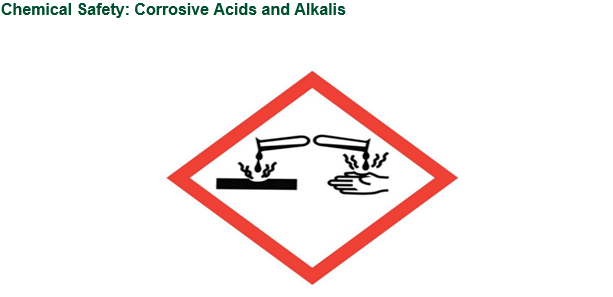
|
|
Ensuring chemical safety is paramount in any laboratory setting, particularly when dealing with corrosive substances such as acids and alkalis. These chemicals, while essential for various academic and research purposes, pose significant risks if not handled properly.
Understanding Corrosive Substances
Corrosive acids and alkalis are substances that can cause severe damage to living tissues, metals, and other materials upon contact. Acids, such as sulfuric acid (H₂SO₄) and hydrochloric acid (HCl), are characterized by their ability to donate protons (H⁺ ions) in aqueous solutions. Alkalis, or bases, such as sodium hydroxide (NaOH) and potassium hydroxide (KOH), are known for their ability to accept protons or donate hydroxide ions (OH⁻) in solutions. Both types of chemicals can cause chemical burns, respiratory issues, and other health hazards if not handled properly.
This article outlines the 12 critical safety measures and best practices for handling them to ensure a safe working environment.
12 Tips for Safe Storage and Handling
Proper Training and Education: Ensure that all personnel handling corrosive substances are adequately trained in chemical safety protocols. This includes understanding the properties of the chemicals, potential hazards, and emergency procedures. This information needs to be specific to the chemicals being used and based on their safety data sheet (SDS).
Use of Personal Protective Equipment (PPE): Always wear appropriate PPE, including lab coats, gloves, safety goggles, and face shields. PPE acts as the last line of defense against chemical exposure.
Labeling and Storage: Clearly label all containers with the chemical name, concentration, and hazard symbols. Store acids and alkalis in separate, well-ventilated areas, away from incompatible substances.
Ventilation: Work in a well-ventilated area or use a chemical fume hood to prevent the accumulation of hazardous vapors. Proper ventilation reduces the risk of inhalation exposure.
Segregation: Store corrosive acids and alkalis separately to prevent dangerous reactions. Acids should be stored away from bases, flammables, and oxidizers. Use dedicated storage cabinets for each type.
|
|
|
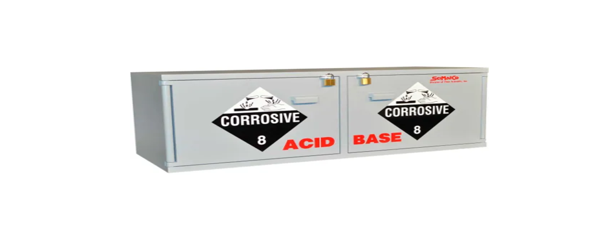
|
|
Secondary Containment: Use secondary containment trays or bins to catch any leaks or spills. This helps prevent the spread of corrosive substances and makes cleanup easier.
Chemical Compatibility: Check the compatibility of storage materials with the corrosive substances. For example, acids should not be stored in metal containers, as they can cause corrosion. Use appropriate materials like glass or plastic.
Periodic Inventory Checks: Conduct regular inventory checks to monitor the quantity and condition of stored chemicals. This helps identify any leaks, expired chemicals, or potential hazards.
Spill Kits: Keep spill kits near storage areas. These kits should include neutralizing agents, absorbent materials, and personal protective equipment for safe spill cleanup. Neutralize acid spills with a weak base (e.g., sodium bicarbonate) and alkali spills with a weak acid.
Safe Handling Techniques: When diluting acids, always add acid to water, not water to acid, to prevent exothermic reactions that can cause splattering. Use appropriate tools and techniques to minimize spills and splashes. Always check the SDS for compatibilities before performing any dilution.
Emergency Preparedness: Have emergency equipment, such as eyewash stations, safety showers, and spill kits, readily available. Ensure that all personnel know the location and proper use of these equipment.
Waste Disposal: Dispose of chemical waste according to UM regulations and guidelines (SAA training). Never pour corrosives or any chemical substances down the drain. Use designated containers for hazardous waste.
Summary
The safe handling of corrosive acids and alkalis is crucial to preventing accidents and ensuring a safe laboratory environment. By adhering to these safety measures and best practices, laboratories can mitigate the risks associated with these hazardous substances. Proper training, the use of PPE, adequate ventilation, and emergency preparedness are key components of a comprehensive chemical safety program. Ultimately, fostering a culture of safety and vigilance is essential for protecting both personnel and the environment from the dangers of corrosive chemicals.
If you have any questions or would like a consultation, please contact Adrian Hernandez Ferrer.
|
|
|
|
Need more information or have any questions?
|
|
|
|